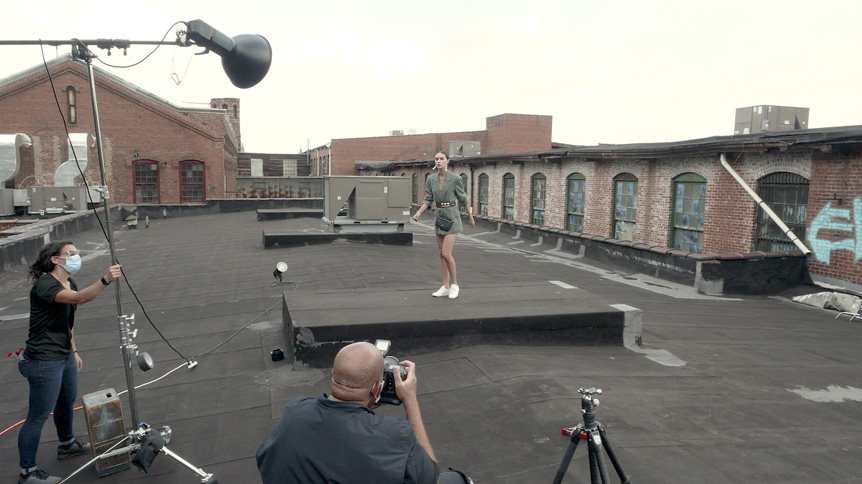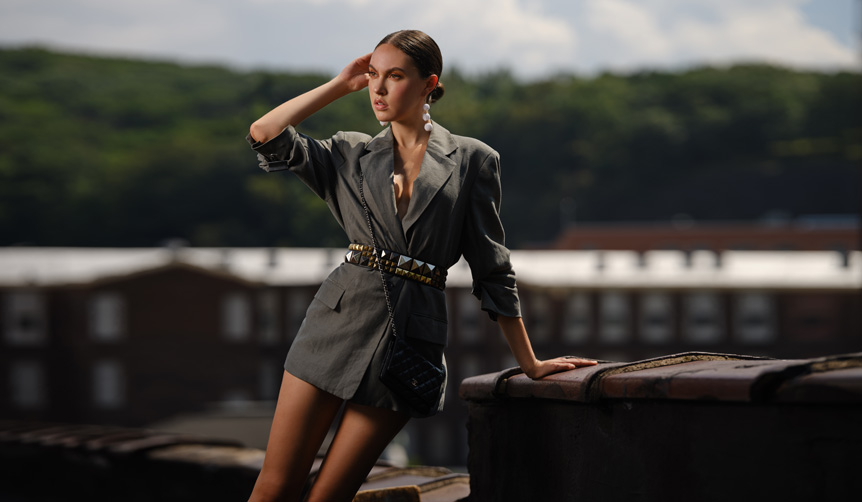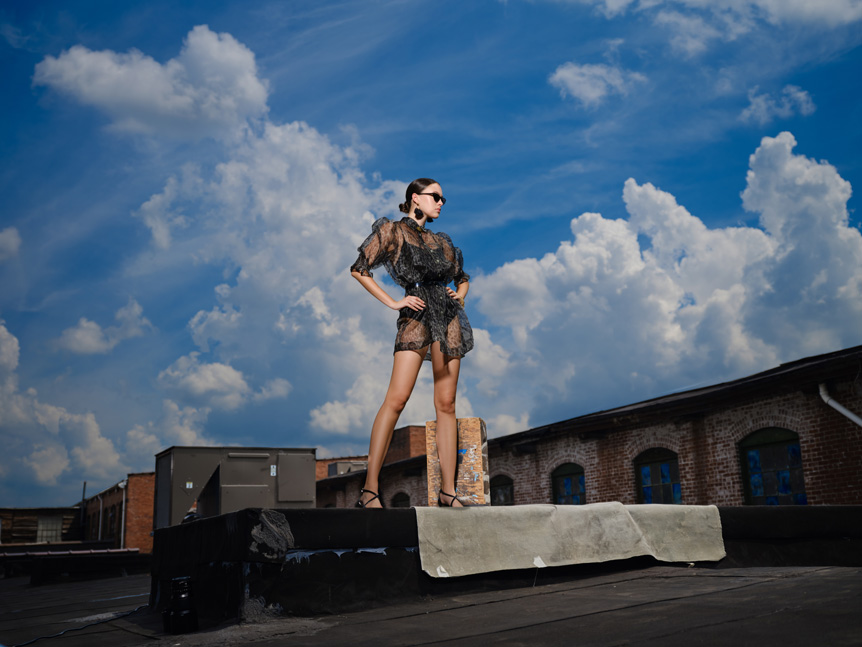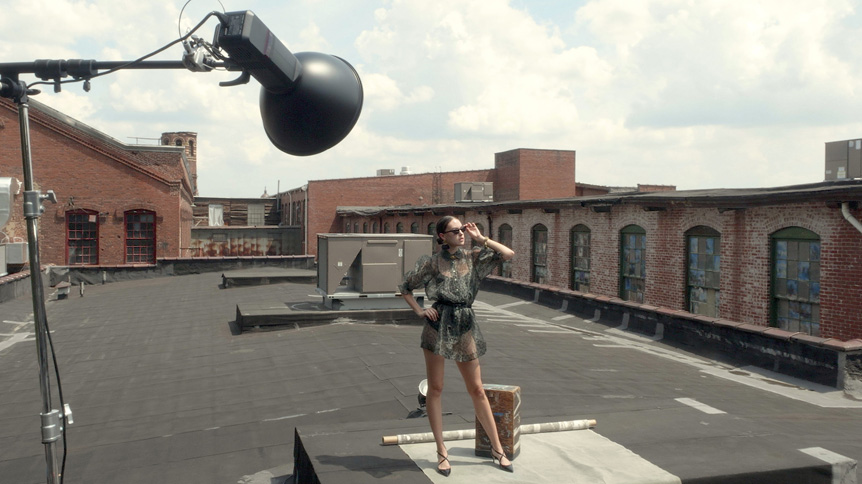
 8 minute read
8 minute read
Get the Look: High Speed Sync
Not all lighting looks are created equal – which is why every skilled photographer should have a versatile bag of techniques. Here’s one you’re sure to remember
High Speed Sync (HSS) is a technique used to combine flash lighting with fast shutter speeds. But before we get into the technical side, you might be wondering why you need to know about it. The main reason for HSS is that it lets you work with flash in bright sunlight, without compromising on aperture and compositional choices. It offers greater flexibility and more options, adding creative control to portraits and fashion photos. HSS is also instrumental in freezing subject movement, so it’s a great fit for action subjects.
Combining the freedom to work in bright sunlight with the ability to freeze motion allows you to take on projects that need a summery or outdoorsy look, as well as introducing movement into your compositions – so it’s a vital skill for fashion, sports, and portrait clients.

Photo 2022 © Ab Sesay
How HSS is Different to Regular Flash
Not all flash systems have HSS, but most modern models do. In HSS mode, the regular single burst of flash is replaced by many pulses of light. These combine during very short exposures to light the subject as desired.
Normally, the shutter speed you can use with flash is limited by the maximum sync speed of your camera. On my FUJIFILM GFX system, the sync speed is 1/125 sec. If you use shutter speeds faster than the sync speed, the effect of the flash may not cover the entire frame – or be visible at all. But in HSS mode, shutter speeds go all the way up to the maximum of the mechanical shutter.
But this extra latitude in shutter speed isn’t ‘free’ – there is a drawback in lighting power. The brightness of the light is no longer independent of the shutter speed, but in fact reduces slightly as the shutter speed increases. In most cases, you will see an initial loss of about three stops of light compared to a regular flash. That said, the lower output of HSS can actually be useful for photographers using very wide apertures, where regular flash would have too much energy.

Photo 2022 © Ab Sesay | FUJIFILM GFX100 and FUJINON GF110mmF2 R LM WR, 1/4000 sec at F2.5, ISO 200
How HSS Helps on Location
The conditions here are midday sun – the kind of light everyone tells you not to work in – but with HSS you can still get great results. In this case, it lets us photograph into the light, while still using a wide aperture and getting a balanced and natural exposure, when regular flash would not.
Let’s look at the situation. In images like this, we don’t want the subject looking in the direction of the sun, because their eyes will end up squinty, and it may cause unflattering shadows on the face. So, we turn them around, putting the sun at their back. This places their face in shadow, but we can brighten it two ways: fill the shadow with flash or reflected light from a panel; or expose for the shadow area. The latter will mean the background is overexposed, so the first option is best. But while a bounce reflector is a good option, it’s not always possible – it can be unwieldy outdoors, and its effect may not be strong enough.
So, we turn to flash. But now we have another problem. In bright sunlight, at the chosen aperture (F2.5) and ISO (200) settings, the shutter (1/4000 sec) is way too high for regular flash. We could close the aperture to F16 or F22, but then lose flash power and subject separation, as the background would be very, very sharp. As depth-of-field control is key, HSS will balance the sunlight.
I used a 3ft softbox at about 6ft from the subject, positioning it to her side. At that angle, the directional light keeps some shadow on the subject’s face, which complements the sunlit backdrop and maintains a natural look, as if the sun was bouncing off a white wall. With the sun to the subject’s back, it acts as a hair light, while also rim lighting the shoulders.

How to Meter for HSS Flash
Metering correctly for HSS will save you time and energy. That’s important on set, because you want everything working efficiently. Also, HSS isn’t as linear in its power as regular flash, so is trickier to calculate. Every time you increase shutter speed by a stop, depending on the light efficiency – and the way it uses HSS – you’re no longer just losing a stop of power. You could be losing a stop and a half, two stops or more.
Here, I was using a Sekonic Speedmaster L-858D-U light meter, which has a dedicated HSS mode, factoring in ambient light as well as the flash output. This gives an ambient to flash percentage, and basically gets my exposure right from the first frame.
A meter helps you work quicker and more accurately, but also saves significant battery life. You’ll most likely be using HSS in conjunction with a battery-powered flash, and working at full power due to the lower output, so you don’t want to be doing lots of test exposures. Wasting valuable exposures can burn through battery, leaving you short later on.

Photo 2022 © Ab Sesay | FUJIFILM GFX100 and FUJINON GF32-64mmF4 R LM WR, 1/4000 sec at F4, ISO 200
HSS for a Dramatic Fashion Image
Aesthetically, this next image is more striking than the first example, but they follow exactly the same principles. It’s an example of how HSS gives you a very punchy result in full sun, letting you master the ambient light. Here, though I could have easily photographed at 1/4000 sec, just using ambient light, I wouldn’t have had control over the ratio – or the angle of light on the subject.
Take a look at the metal object behind the subject. If I wasn’t using flash, that is the kind of light I would have ended up with. The sun is high up on camera right, giving lots of contrast in the scene and texture in the clouds. Without HSS flash, we would have had very deep shadows on the model, too – a problem for a fashion image, as it would not show the clothes as desired. Large reflector panels or silks would calm down the contrast, but they can be unwieldy compared to flash.

In this image, I was wanting control over the sky. Using HSS flash, I can darken it a little to make the subject stand out – and use that ratio to increase contrast and draw the eye. The whites of the clouds are underexposed by about two stops in comparison with the highlight on her cheek. Underexposing the sky makes the blues deeper and more effective. The ratio here leaves the subject looking deliberately ‘lit’. It fits with the punchier look we’re after. If I wanted a more natural look, I would just bring the ambient and flash ratio closer together. Going back to the highlight on her cheek, the whites of the clouds would be more similar to that.

Photo 2022 © Ab Sesay
Here, we are using two HSS-equipped flashes with 600Ws of power. The main light is to camera right, and uses a magnum sports reflector – making a hard light source that maintains the quality of direct sunlight. It is moved to her front a little more to reduce shadow. There’s also an accent light behind her, increasing separation and adding definition, with that light using a standard zoom reflector.
The reflectors suit the sun, but also increase efficiency. Remember, we are losing power in HSS mode, that is important. Any diffusion costs power, but if I wanted more softness, instead of a softbox, I would use a 6x6ft frame with a silk on it, then fire several lights through it to offset the loss in power.

Photo 2022 © Ab Sesay | FUJIFILM GFX100 and FUJINON GF32-64mmF4 R LM WR, 1/4000 sec at F5.6, ISO 200
HSS Makes Freezing Motion Easier
Another huge benefit of HSS is that it lets you freeze subject motion more easily than regular flash in ambient light. Conversely, regular flash in ambient light often shows motion blur or ghosting. For instance, in an exposure of 1/125 sec at F16, the regular flash duration freezes the movement, but the ambient exposure still shows blur around it. Working at speeds like 1/500 sec or above in HSS mode, there is less and less motion blur visible the faster you go. It’s therefore perfect for projects involving sports and activewear brands.
HSS on a Smaller Scale
Power is a big factor with HSS flash, so if you’re using less powerful heads or speedlights, energy output is a main concern. This can be tackled in two ways. The first is to organize the session in dimmer conditions, working more towards the beginning or end of the day, when ambient light is less intense and you can use slower shutter speed.
The second is with multiple HSS-equipped flashes at once, increasing the output and bringing it closer to that of a single, more powerful head. For instance, a bracket that can hold multiple speedlights. Remember, though, that while going from one speedlight to two will double the output and provide an extra stop of power, to double it again, you’ll need two more flashes, and so on.
In the next article, we look at how to recreate the effects of sunlight in a controlled setup that can be used all day long, lighting the subject and the space for a natural, but effective look.





















































